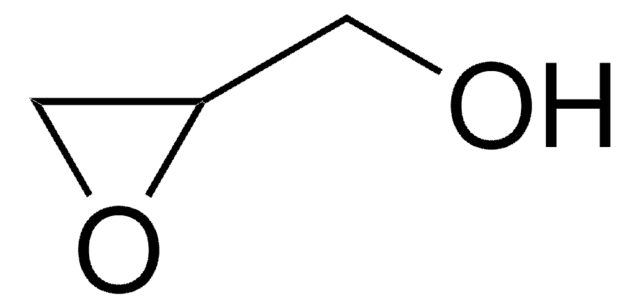202533
1,3-Butadiene diepoxide
97%
Synonyme(s) :
1,2,3,4-Diepoxybutane
About This Item
Produits recommandés
Pression de vapeur
25 mmHg ( 56 °C)
Niveau de qualité
Essai
97%
Forme
liquid
Impuretés
<3% methylene chloride
Indice de réfraction
n20/D 1.434 (lit.)
pb
56-58 °C/25 mmHg (lit.)
Pf
2-4 °C (lit.)
Densité
1.113 g/mL at 25 °C (lit.)
Température de stockage
2-8°C
Chaîne SMILES
C1OC1C2CO2
InChI
1S/C4H6O2/c1-3(5-1)4-2-6-4/h3-4H,1-2H2
Clé InChI
ZFIVKAOQEXOYFY-UHFFFAOYSA-N
Vous recherchez des produits similaires ? Visite Guide de comparaison des produits
Catégories apparentées
Description générale
Application
- As a precursor to synthesize microstructured poly(amino alcohol ethers) hydrogels for drug delivery and tissue engineering. It helps to enhance mechanical strength and thermal responsiveness of hydrogels.
- As a cross-linker for the green synthesis of hemostatic epoxy-amine sponge for management of bleeding. It facilitates the formation of a three-dimensional network within the epoxy-amine matrix.
Mention d'avertissement
Danger
Mentions de danger
Classification des risques
Acute Tox. 1 Inhalation - Acute Tox. 2 Dermal - Acute Tox. 3 Oral - Carc. 1B - Eye Dam. 1 - Flam. Liq. 3 - Muta. 1B - Skin Corr. 1B
Code de la classe de stockage
3 - Flammable liquids
Classe de danger pour l'eau (WGK)
WGK 3
Point d'éclair (°F)
114.8 °F - closed cup
Point d'éclair (°C)
46 °C - closed cup
Équipement de protection individuelle
Faceshields, Gloves, Goggles, type ABEK (EN14387) respirator filter
Faites votre choix parmi les versions les plus récentes :
Déjà en possession de ce produit ?
Retrouvez la documentation relative aux produits que vous avez récemment achetés dans la Bibliothèque de documents.
Notre équipe de scientifiques dispose d'une expérience dans tous les secteurs de la recherche, notamment en sciences de la vie, science des matériaux, synthèse chimique, chromatographie, analyse et dans de nombreux autres domaines..
Contacter notre Service technique











